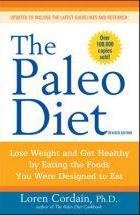- Home
- Blog
- Healthy Weight Loss
- Diet Book review: The Paleo (Paleolithic) Diet
Diet Book review: The Paleo (Paleolithic) Diet
Written by Catherine Saxelby
on Monday, 26 July 2010.
Tagged: diets, health, healthy eating, overweight, protein, vegetables, weight loss

Was meat the main fare of our early Stone Age ancestors? What did our primitive hunter-gatherer ancestors live on? Our prehistoric diet - the diet that sustained the human race throughout two million years of evolution - has intrigued scientists for years.
Now a group of paleobiologists, nutritionists and archeologists, have come up with what they feel is a fairly accurate picture of what our early Hominids consumed.
Using fossil records, bone mineral studies and dental reconstructions, they have studied 229 different primitive societies and deduced that the majority of them derived more than HALF of their food from animal food that they hunted or fished.
The menu
Professor Loren Cordain of Colorado State University has spearheaded the team and reported that stone age people ate the following way:
- One-third of their diet was derived from hunted prey like bison, bears, kangaroo, buffalo, deer and elephants.
- One-third came from fish and seafood.
- One third was from gathered plant foods such as root vegetables, leaves, fruit, wild berries and nuts.
- Additional protein was eaten in the form of birds as well as reptiles, insects and small mammals.
No society relied entirely on plants, as it was much more ‘energy efficient' to eat animals. In other words, by eating meat, they would gain the most kilojoules/Calories for the least effort.
In contrast, if they lived on vegetables and berries (which are generally low in calories), they would have to expend many more calories searching and gathering these than their ‘calorie return'.
Think about how hunter-gatherers ate:
- No grains were consumed as the cultivation of cereals had not yet begun.
- Nor was milk and dairy foods consumed.
- Eggs were an odd treat if you were lucky enough to stumble over a nest.
- Honey from wild bees was much prized (yet worth the risk of being stung to go after).
- There was nothing pre-prepared or take away!
Whole carcass
Interestingly hunter-gathers ate not just the lean muscle but the whole carcass. The preferred parts were the organs (kidney, liver, heart), any tissues of the head and the fat.
Pros
- No grains and no sugar eliminate high-kilojoule junk food such as lollies, fizzy drink, chocolate, muffins, cookies and rich desserts.
- It's an easy diet to stick to if you dine out a lot. Simply order steak and salad or else grilled fish and vegetables but skip the chips or potato.
- It favours weight loss due to its high protein content which is very filling/satisfying and may increase muscle mass.
Cons
- It's expensive. You pay a lot for fish, meat, chicken while potato and pasta are relatively cheap inexpensive fare.
- Without grains and legumes, it's on the low side for carbs but is way better than diets like Dukan or Atkins. It's good that it cuts out the junk carbs such as white bread and white ric. However I'd add in 2 serves of whole grains OR high fibre and low GI types like lentils and pasta.
- Does not replicate exactly how our ancestors ate – they would have gorged on a kill or catch but then had long periods with little or no food (semi-starvation).
- Cutting out grains eliminates a key source of B vitamins, fibre and minerals such as phosphorus and magnesium.
- Researchers say our bodies have adapted to grains over thousands of years as long as they're whole grains, not refined.
- It's not easy for vegetarians and almost impossible for vegans who rely on legumes and grains so much.
- You're eating modern equivalents such as meat from domesticated animals raised using mass production methods, even if grass-fed, not wild beasts roaming the plains.
- You still need to exercise – the Paleo people would have spent their whole day foraging or hunting and burned off lots of energy.
Ideal diet for the 21 century?
This was the diet that kept stone age people lean and healthy. Apparently, they were tall and more muscled than we are today with strong teeth and bones. Their intake of most nutrients was high, thanks to lean meat, wild vegetables, and no sugar or junk food.
But their life span was only 25 years, as injuries, infections and childbirth took their toll. In contrast, we live until our 80s, an age that makes us prone to degenerative diseases of old age.
There is little doubt about the health potential of such a diet; however adoption in its entirety is probably a little unrealistic. But there is nothing wrong with increasing your intake of vegetables and fruits, reducing processed and refined carbohydrates, eating more fish and lean meat, and increasing physical activity, all aspects of the Stone Age diet that nutritionists recommend.
Interested in reading more?
Buy the book The Paleo Diet by Dr Loren Cordain, researcher at Colorado State University and founder of the Paleo movement, from the Book Depository online bookshop (my favourite place to buy books with free shipping worldwide).
Or you may prefer the cookbook by the same author:
Save
Save
You may also be interested in...
Foodwatch
The Good Stuff
The Boring Stuff
© 2025 Foodwatch Australia. All rights reserved
Website by Joomstore eCommerce







